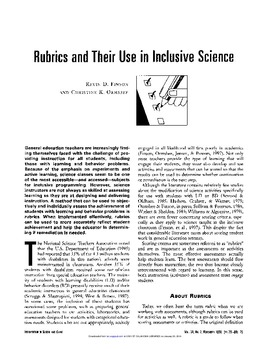| dc.contributor.author | Kevin D. Finson | |
| dc.contributor.author | Christine K. Ormsbee | |
| dc.date.accessioned | 2016-01-14T19:53:24Z | |
| dc.date.accessioned | 2016-03-30T15:33:50Z | |
| dc.date.available | 2016-01-14T19:53:24Z | |
| dc.date.available | 2016-03-30T15:33:50Z | |
| dc.date.issued | 1998-11-01 | |
| dc.identifier.citation | Finson, K. D., & Ormsbee, C. K. (1998). Rubrics and Their Use in Inclusive Science. Intervention in School and Clinic, 34(2), 79-88. doi: 10.1177/105345129803400203 | en_US |
| dc.identifier.uri | https://hdl.handle.net/11244/25232 | |
| dc.description.abstract | General education teachers are increasingly finding themselves faced with the challenge of providing instruction for all students, including those with learning and behavior problems. Because of the emphasis on experiments and active learning, science classes seem to be one of the most accessible—and accessed—subjects for inclusive programming. However, science instructors are not always as skilled at assessing learning as they are at designing and delivering instruction. A method that can be used to objectively and individually assess the achievement of students with learning and behavior problems is rubrics. When implemented effectively, rubrics can be used to more accurately reflect student achievement and help the educator in determining if remediation is needed. | en_US |
| dc.language.iso | en_US | en_US |
| dc.publisher | Intervention in School and Clinic | |
| dc.title | Rubrics and Their Use in Inclusive Science | en_US |
| dc.type | Research Article | en_US |
| dc.description.peerreview | Yes | en_US |
| dc.description.peerreviewnotes | https://us.sagepub.com/en-us/nam/manuscript-submission-guidelines | en_US |
| dc.identifier.doi | 10.1177/105345129803400203 | en_US |
| dc.rights.requestable | false | en_US |
